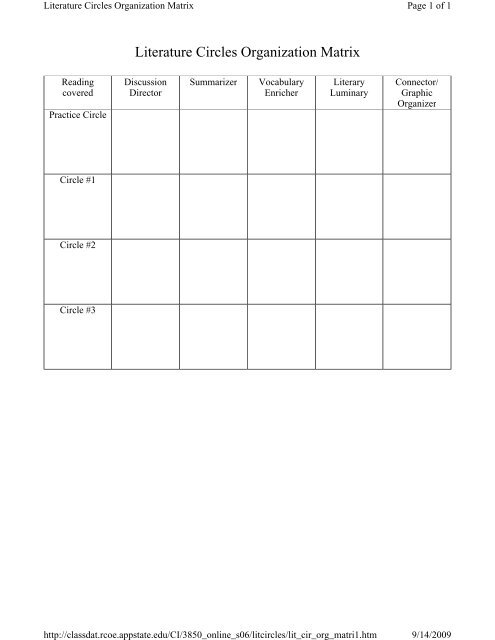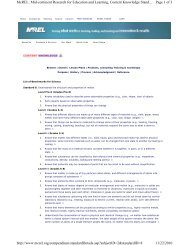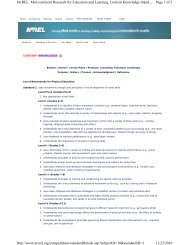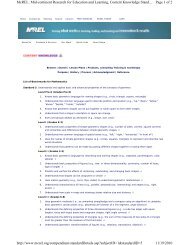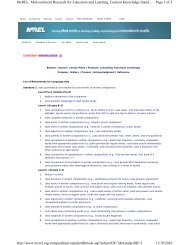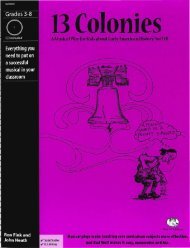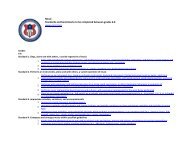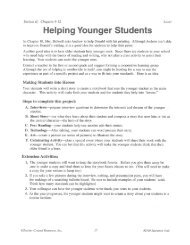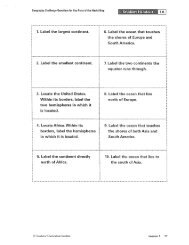Literacy Circle Packet.pdf
Literacy Circle Packet.pdf
Literacy Circle Packet.pdf
Create successful ePaper yourself
Turn your PDF publications into a flip-book with our unique Google optimized e-Paper software.
Literature <strong>Circle</strong>s Organization Matrix<br />
http://classdat.rcoe.appstate.edu/CI/3850_online_s06/litcircles/lit_cir_org_matri1.htm<br />
Page 1 of 1<br />
9/14/2009<br />
Literature <strong>Circle</strong>s Organization Matrix<br />
Reading<br />
covered<br />
Practice <strong>Circle</strong><br />
Discussion<br />
Director<br />
Summarizer<br />
Vocabulary<br />
Enricher<br />
Literary<br />
Luminary<br />
Connector/<br />
Graphic<br />
Organizer<br />
<strong>Circle</strong> #1<br />
<strong>Circle</strong> #2<br />
<strong>Circle</strong> #3
Discussion Director<br />
Name:<br />
Group:<br />
Book:<br />
Discussion Director: Your job is to develop a list of questions that your group might want to<br />
discuss about this part of the book. Remember, the best questions are often ones you don't know<br />
the answer for but are just curious about. Don't worry about the small details: your task is to help<br />
people talk over the big ideas in the reading and share their reactions. Usually the best discussion<br />
questions come from your own thoughts, feelings, and concerns as you read, which you can list<br />
below, during or after your reading. Or you may use some of the general questions below to<br />
develop topics for your group.<br />
Your job is to lead the discussion, keep people on task, and help others understand by asking<br />
good questions while the discussion is taking place. Sometimes you need to make up a question<br />
"on the spot."<br />
Possible discussion questions or topics for today:<br />
1.<br />
2.<br />
3.<br />
4.<br />
Sample questions:<br />
What was going through your mind while you read this? How did you feel while reading this<br />
part of the book?<br />
What was discussed in this section of the book?<br />
Did today's reading remind you of any real-life experiences?<br />
What questions did you have when you finished this section?<br />
Did anything in this section of the book surprise you?<br />
What are the one or two most important ideas?
Summarizer<br />
http://classdat.rcoe.appstate.edu/CI/3850_online_s06/litcircles/summarizer.html<br />
Page 1 of 1<br />
9/14/2009<br />
Summarizer<br />
Name:<br />
Group:<br />
Book:<br />
Assignment :<br />
Summarizer: Your job is to prepare a brief summary of today's reading. Your group discussion will<br />
start with your 1-2 minute statement that covers the key points, main highlights and general idea of<br />
today's reading assignment.<br />
Summary:<br />
Key Points:<br />
1.<br />
2.<br />
3.<br />
4.<br />
Topic to be carried over to tomorrow?<br />
Next Assignment:<br />
Connections: What did today's reading remind you of or make you think about in your life?
Vocabulary Enricher<br />
Name:<br />
Group:<br />
Book:<br />
Vocabulary Enricher: Your job is to be on the lookout for a few especially important words in<br />
today's reading. If you find words that are puzzling or unfamiliar, mark them while you are<br />
reading, and then later jot down their definition, either from a dictionary or some other source.<br />
You 'May also run across familiar words that stand out somehow in the reading - words that are<br />
repeated a lot, used in an unusual way, or key to the meaning of the text. Mark these special words<br />
too, and be ready to point them out to the group. When your circle meets, help members find and<br />
discuss these words.<br />
Page &<br />
Paragraph<br />
Number<br />
Word<br />
Definition
Literary Luminary<br />
http://classdat.rcoe.appstate.edu/CI/3850_online_s06/litcircles/literary.html<br />
Page 1 of 1<br />
9/14/2009<br />
Literary Luminary<br />
Name:<br />
Group:<br />
Book:<br />
Assignment :<br />
Literary Luminary: Your job is to locate a few special sections of the text that your group would like to hear<br />
read aloud. The idea is to help people remember some interesting, powerful, funny, puzzling; or important sections of the<br />
text. You decide which passages or paragraphs are worth hearing, and then jot plans for how they should be<br />
shared. You can read passages aloud yourself, ask someone else to read them, or have people read them silently.<br />
Discuss each selection of text. Plan ahead. How do you feel about the selected section?<br />
Location<br />
Page:<br />
Paragraph:<br />
Page:<br />
Paragraph:<br />
Page:<br />
Paragraph:<br />
Page:<br />
Paragraph:<br />
Page:<br />
Paragraph:<br />
Reason for Picking<br />
Plan for sharing the text<br />
Reasons might include: funny, sad, puzzling, confusing, well written, descriptive, etc .....<br />
Plan for sharing might include: read aloud, have someone else read aloud, silent reading, etc...<br />
Plan for sharing should include related questions you might ask.<br />
Topic to be carried over to tomorrow?<br />
Next Assignment:<br />
Connections: What did today's reading remind you of or make you think about in your life?
Connector & Graphic Organizer<br />
Name:<br />
Group:<br />
Book:<br />
Connector: Your job is to find connections between the book your group is reading and the<br />
world outside. This means connecting the reading to your own life, to happenings at school or in<br />
the community, to similar events at other times and places, to other people or problems that you<br />
are reminded of. You might also see connections between this book and other books, movies, or<br />
stories you've heard. There are no right answers here - whatever the reading connects you with is<br />
worth sharing!<br />
Some connections I found between this reading and other people, places, events, authors...<br />
1.<br />
2.<br />
3.<br />
Graphic Organizer: Make something VISUAL. Your job is to do one of the following:<br />
1. Illustrator: Draw some kind of picture related to the reading. It can be a sketch, cartoon,<br />
diagram, flow chart or stick-figure scene. You can draw a picture of something that's discussed<br />
specifically in your book, or something that the reading reminded you of. You can draw a picture<br />
that conveys any idea or feeling you got from the reading. You can even label things with words<br />
if that helps. Make your drawing on the back of this paper.<br />
2. Travel Tracer: When you are reading a book where characters move around a lot and the<br />
scene changes frequently, it is important for everyone in your group to know where things are<br />
happening and how the setting may have changed. So that's your job: to track carefully where the<br />
action takes place during today's reading. Describe each setting in detail, either in words or with<br />
an action map or diagram or a timeline you can show to your group. Be sure to give the page<br />
locations where the scene is described. Describe or sketch the setting. Use the back of this sheet.<br />
3. Web Master: Create a web that summarizes the assigned reading. Put the main pieces of the<br />
story line into your web. Don't list small details, but focus on the big picture.


